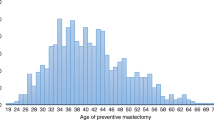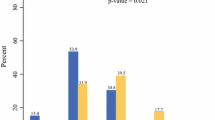Abstract
Background
The rate of risk-reducing bilateral mastectomy (RRBM) among cancer-free Israeli female BRCA1/BRCA2 mutation carriers was reportedly 13% in 2010. Current RRBM rates in Israel and factors seemingly associated with opting for RRBM were reevaluated.
Methods
Israeli female cancer-free BRCA1/BRCA2 mutation carriers, who were followed at the high-risk clinic at Sheba Medical Center between January 2011 and April 2020 were eligible. Univariate Cox regression and log-rank test were used to study the crude association between potential predictors and performance of RRBM.
Results
Overall, 427 cancer-free BRCA1 (n = 218) or BRCA2 (n = 209) mutation carriers were included. Median age at genotyping was 33.6 years (interquartile range 26.8–41.8 years), median follow-up 4.4 years (range 0.1–7.6 years). Overall, 41/427 (9.6%) participants underwent RRBM, all of them within 5 years of genotyping. Being married (HR-2.57, p = 0.017) and having a first degree relative with breast cancer (BC) (HR-2.19, p = 0.017) were positively associated with RRBM, whereas any previous benign breast biopsy was negatively associated (HR-0.48, p = 0.029) with performing RRBM.
Conclusions
RRBM is still infrequently elected by Israeli BRCA1/BRCA2 mutation carriers, with married women with one relative with BC who have not undergone previous breast biopsy more likely to opt for RRBM.

Similar content being viewed by others
Data availability
The data that support the findings of this study are available from the corresponding author upon reasonable request.
References
Mavaddat N, Peock S, Frost D et al (2013) Cancer risks for BRCA1 and BRCA2 mutation carriers: results from prospective analysis of EMBRACE. J Natl Cancer Inst 105:812–822. https://doi.org/10.1093/jnci/djt095
Kuchenbaecker KB, Hopper JL, Barnes DR et al (2017) Risks of breast, ovarian, and contralateral breast cancer for BRCA1 and BRCA2 mutation carriers. JAMA 317:2402–2416. https://doi.org/10.1001/jama.2017.7112
Antoniou A, Pharoah PDP, Narod S et al (2003) Average risks of breast and ovarian cancer associated with BRCA1 or BRCA2 mutations detected in case series unselected for family history: a combined analysis of 22 studies. Am J Hum Gen 72:1117–1130. https://doi.org/10.1086/375033
Petrucelli N, Daly MB, Feldman GL (2010) Hereditary breast and ovarian cancer due to mutations in BRCA1 and BRCA2. Gen Med 12:245–259. https://doi.org/10.1097/GIM.0b013e3181d38f2f
Abul-Husn NS, Soper ER, Odgis JA et al (2019) Exome sequencing reveals a high prevalence of BRCA1 and BRCA2 founder variants in a diverse population-based biobank. Genome Med 12:2. https://doi.org/10.1186/s13073-019-0691-1
Manickam K, Buchanan AH, Schwartz MLB et al (2018) Exome sequencing-based screening for BRCA1/2 expected pathogenic variants among adult biobank participants. JAMA Netw Open 1:e182140–e182140. https://doi.org/10.1001/jamanetworkopen.2018.2140
Roa BB, Boyd AA, Volcik K, Richards CS (1996) Ashkenazi Jewish population frequencies for common mutations in BRCA1 and BRCA2. Nat Genet 14:185–187. https://doi.org/10.1038/ng1096-185
Warner E, Plewes DB, Hill KA et al (2004) Surveillance of BRCA1 and BRCA2 mutation carriers with magnetic resonance imaging, ultrasound, mammography, and clinical breast examination. JAMA 292:1317–1325. https://doi.org/10.1001/jama.292.11.1317
NCCN guidelines for detection, prevention, & risk reduction. https://www.nccn.org/professionals/physician_gls/pdf/genetics_bop.pdf. Accessed 16 Aug 2020
Rebbeck TR, Friebel T, Lynch HT et al (2004) Bilateral prophylactic mastectomy reduces breast cancer risk in BRCA1 and BRCA2 mutation carriers: the PROSE study Group. JCO 22:1055–1062. https://doi.org/10.1200/JCO.2004.04.188
Hartmann LC, Sellers TA, Schaid DJ et al (2001) Efficacy of bilateral prophylactic mastectomy in BRCA1 and BRCA2 gene mutation carriers. J Natl Cancer Inst 93:1633–1637. https://doi.org/10.1093/jnci/93.21.1633
Evans DGR, Lalloo F, Ashcroft L et al (2009) Uptake of risk-reducing surgery in unaffected women at high risk of breast and ovarian cancer is risk, age, and time dependent. Cancer Epidemiol Biomarkers Prev 18:2318–2324. https://doi.org/10.1158/1055-9965.EPI-09-0171
Skytte A-B, Gerdes A-M, Andersen MK et al (2010) Risk-reducing mastectomy and salpingo-oophorectomy in unaffected BRCA mutation carriers: uptake and timing*. Clin Genet 77:342–349. https://doi.org/10.1111/j.1399-0004.2009.01329.x
Laitman Y, Vaisman Y, Feldman D et al (2014) Rates of risk-reducing surgery in Israeli BRCA1 and BRCA2 mutation carriers. Clin Genet 85:68–71. https://doi.org/10.1111/cge.12149
Friebel TM, Domchek SM, Neuhausen SL et al (2007) Bilateral prophylactic oophorectomy and bilateral prophylactic mastectomy in a prospective cohort of unaffected BRCA1 and BRCA2 mutation carriers. Clin Breast Cancer 7:875–882. https://doi.org/10.3816/CBC.2007.n.053
Phillips K-A, Jenkins MA, Lindeman GJ et al (2006) Risk-reducing surgery, screening and chemoprevention practices of BRCA1 and BRCA2 mutation carriers: a prospective cohort study. Clin Genet 70:198–206. https://doi.org/10.1111/j.1399-0004.2006.00665.x
Meijers-Heijboer E, Verhoog L, Brekelmans C et al (2000) Presymptomatic DNA testing and prophylactic surgery in families with a BRCA1 or BRCA2 mutation. The Lancet 355:2015–2020. https://doi.org/10.1016/S0140-6736(00)02347-3
Metcalfe K, Eisen A, Senter L et al (2019) International trends in the uptake of cancer risk reduction strategies in women with a BRCA1 or BRCA2 mutation. Br J Cancer 121:15–21. https://doi.org/10.1038/s41416-019-0446-1
Metcalfe KA, Esplen MJ, Goel V, Narod SA (2004) Psychosocial functioning in women who have undergone bilateral prophylactic mastectomy. Psycho-Oncology 13:14–25. https://doi.org/10.1002/pon.726
Bernstein-Molho R, Kaufman B, Ben David MA et al (2020) Breast cancer surveillance for BRCA1/2 mutation carriers—is “early detection” early enough? The Breast 49:81–86. https://doi.org/10.1016/j.breast.2019.10.012
Jolie A (2013) Opinion|my medical choice. The New York Times, New York
Liede A, Cai M, Crouter TF et al (2018) Risk-reducing mastectomy rates in the US: a closer examination of the Angelina Jolie effect. Breast Cancer Res Treat 171:435–442. https://doi.org/10.1007/s10549-018-4824-9
Mao J, Jorm L, Sedrakyan A (2018) Trends in use of risk-reducing mastectomy in a context of celebrity decisions and media coverage: an observational study in the United States and Australia. Health Serv Res 53:2682–2695. https://doi.org/10.1111/1475-6773.12774
Evans DG, Wisely J, Clancy T et al (2015) Longer term effects of the Angelina Jolie effect: increased risk-reducing mastectomy rates in BRCA carriers and other high-risk women. Breast Cancer Res 17:143. https://doi.org/10.1186/s13058-015-0650-8
Desai S, Jena AB (2016) Do celebrity endorsements matter? Observational study of BRCA gene testing and mastectomy rates after Angelina Jolie’s New York Times editorial. BMJ. https://doi.org/10.1136/bmj.i6357
Metcalfe KA, Birenbaum-Carmeli D, Lubinski J et al (2008) International variation in rates of uptake of preventive options in BRCA1 and BRCA2 mutation carriers. Int J Cancer 122:2017–2022. https://doi.org/10.1002/ijc.23340
Kram V, Peretz T, Sagi M (2006) Acceptance of preventive surgeries by Israeli women who had undergone BRCA testing. Fam Cancer 5:327–335. https://doi.org/10.1007/s10689-006-0002-z
סרטן תורשתי | Israel | Bracha.org.il עמותת ברכה. In: Bracha. https://www.bracha.org.il. Accessed 10 Aug 2020
Wainberg S, Husted J (2004) Utilization of screening and preventive surgery among unaffected carriers of a BRCA1 or BRCA2 gene mutation. Cancer Epidemiol Biomarkers Prev 13:1989–1995
Henry DA, Lee MC, Almanza D et al (2019) Trends in use of bilateral prophylactic mastectomy vs high-risk surveillance in unaffected carriers of inherited breast cancer syndromes in the Inherited Cancer Registry (ICARE). Breast Cancer Res Treat 174:39–45. https://doi.org/10.1007/s10549-018-5057-7
Julian-Reynier CM, Bouchard LJ, Evans DG et al (2001) Women’s attitudes toward preventive strategies for hereditary breast or ovarian carcinoma differ from one country to another. Cancer 92:959–968. https://doi.org/10.1002/1097-0142(20010815)92:4<959:AID-CNCR1406>3.0.CO;2-V
Metcalfe KA, Ghadirian P, Rosen B et al (2007) Variation in rates of uptake of preventive options by Canadian women carrying the BRCA1 or BRCA2 genetic mutation. Open Med 1:e92–e98
Julian-Reynier C, Eisinger F, Moatti J-P, Sobol H (2000) Physicians’ attitudes towards mammography and prophylactic surgery for hereditary breast/ovarian cancer risk and subsequently published guidelines. Eur J Hum Genet 8:204–208. https://doi.org/10.1038/sj.ejhg.5200418
Eisinger F, Stoppa-Lyonnet D, Lasset C et al (2001) Comparison of physicians’ and cancer prone women’s attitudes about breast/ovarian prophylactic surgery Results from two national surveys. Familial Cancer 1(3–4):157–162
Dhar SU, Cooper HP, Wang T et al (2011) Significant differences among physician specialties in management recommendations of BRCA1 mutation carriers. Breast Cancer Res Treat 129:221–227. https://doi.org/10.1007/s10549-011-1449-7
Bouchard L, Blancquaert I, Eisinger F et al (2004) Prevention and genetic testing for breast cancer: variations in medical decisions. Soc Sci Med 58:1085–1096. https://doi.org/10.1016/S0277-9536(03)00263-6
Manoukian S, Alfieri S, Bianchi E et al (2019) Risk-reducing surgery in BRCA1/BRCA2 mutation carriers: are there factors associated with the choice? Psychooncology 28:1871–1878. https://doi.org/10.1002/pon.5166
Tong A, Kelly S, Nusbaum R et al (2015) Intentions for risk-reducing surgery among high-risk women referred for BRCA1/BRCA2 genetic counseling. Psychooncology 24:33–39. https://doi.org/10.1002/pon.3560
van Driel CMG, Oosterwijk JC, Meijers-Heijboer EJ et al (2016) Psychological factors associated with the intention to choose for risk-reducing mastectomy in family cancer clinic attendees. Breast 30:66–72. https://doi.org/10.1016/j.breast.2016.08.016
Rebitschek FG, Pashayan N, Widschwendter M, Wegwarth O (2019) Do cancer risk and benefit–harm ratios influence women’s consideration of risk-reducing mastectomy? A scenario-based experiment in five European countries. PLoS One. https://doi.org/10.1371/journal.pone.0218188
Hutson SP (2007) Attitudes and psychological impact of genetic testing, genetic counseling, and breast cancer risk assessment among women at increased risk. Oncol Nurs Forum 30:241–246. https://doi.org/10.1188/03.ONF.241-246
Singh K, Lester J, Karlan B et al (2013) Impact of family history on choosing risk-reducing surgery among BRCA mutation carriers. Am J Obstet Gynecol 208:329.e1–329.e6. https://doi.org/10.1016/j.ajog.2013.01.026
Schwartz MD, Isaacs C, Graves KD et al (2012) Long-term outcomes of BRCA1/BRCA2 testing: risk reduction and surveillance. Cancer 118:510–517. https://doi.org/10.1002/cncr.26294
Gilbert E, Zabor EC, Stempel M et al (2017) Differences among a modern cohort of BRCA mutation carriers choosing bilateral prophylactic mastectomies compared to breast surveillance. Ann Surg Oncol 24:3048–3054. https://doi.org/10.1245/s10434-017-5976-2
Mavaddat N, Barrowdale D, Andrulis IL et al (2012) Pathology of breast and ovarian cancers among BRCA1 and BRCA2 mutation carriers: results from the consortium of investigators of modifiers of BRCA1/2 (CIMBA). Cancer Epidemiol Biomarkers Prev 21:134–147. https://doi.org/10.1158/1055-9965.EPI-11-0775
Krammer J, Pinker-Domenig K, Robson ME et al (2017) Breast cancer detection and tumor characteristics in BRCA1 and BRCA2 mutation carriers. Breast Cancer Res Treat 163:565–571. https://doi.org/10.1007/s10549-017-4198-4
Uyei A, Peterson SK, Erlichman J et al (2006) Association between clinical characteristics and risk-reduction interventions in women who underwent BRCA1 and BRCA2 testing. Cancer 107:2745–2751. https://doi.org/10.1002/cncr.22352
Israeli Central Bureau of Statitics - cbs.gov.il. https://www.cbs.gov.il/he/Pages/default.aspx. Accessed 10 Aug 2020
Heemskerk-Gerritsen BAM, Jager A, Koppert LB et al (2019) Survival after bilateral risk-reducing mastectomy in healthy BRCA1 and BRCA2 mutation carriers. Breast Cancer Res Treat 177:723–733. https://doi.org/10.1007/s10549-019-05345-2
Carbine NE, Lostumbo L, Wallace J, Ko H (2018) Risk-reducing mastectomy for the prevention of primary breast cancer. Cochrane Database Syst Rev 4:CD002748. https://doi.org/10.1002/14651858.CD002748.pub4
Acknowledgements
Statistical analysis was done by Ziv-Bar company, 20 Haazmon st, Holon, Israel. The authors did not have any writing assistance.
Funding
This research did not receive any specific grant from funding agencies in the public, commercial, or not-for-profit sectors.
Author information
Authors and Affiliations
Contributions
Conceptualization: RB-M, EF, DMF; methodology: LG; YL, DZ, MSL; formal analysis and investigation: LG; writing—original draft preparation: LG, RB-M; writing—review and editing: all authors; supervision: RB-M, EF.
Corresponding author
Ethics declarations
Conflict of interest statement
All authors declare that they have no conflict of interest.
Ethical approval
All procedures performed in this study were in accordance with the ethical standards of the institutional and/or national research committee and with the 1964 Helsinki declaration and its later amendments or comparable ethical standards.
Additional information
Publisher's Note
Springer Nature remains neutral with regard to jurisdictional claims in published maps and institutional affiliations.
This work was performed as a part of the requirements for the MD degree from the Sackler School of Medicine, Tel-Aviv University, Tel-Aviv, Israel (L.G.).
Rights and permissions
About this article
Cite this article
Galmor, L., Bernstein-Molho, R., Sklair-Levy, M. et al. Time trends in uptake rates of risk-reducing mastectomy in Israeli asymptomatic BRCA1 and BRCA2 mutation carriers. Breast Cancer Res Treat 185, 391–399 (2021). https://doi.org/10.1007/s10549-020-05949-z
Received:
Accepted:
Published:
Issue Date:
DOI: https://doi.org/10.1007/s10549-020-05949-z




